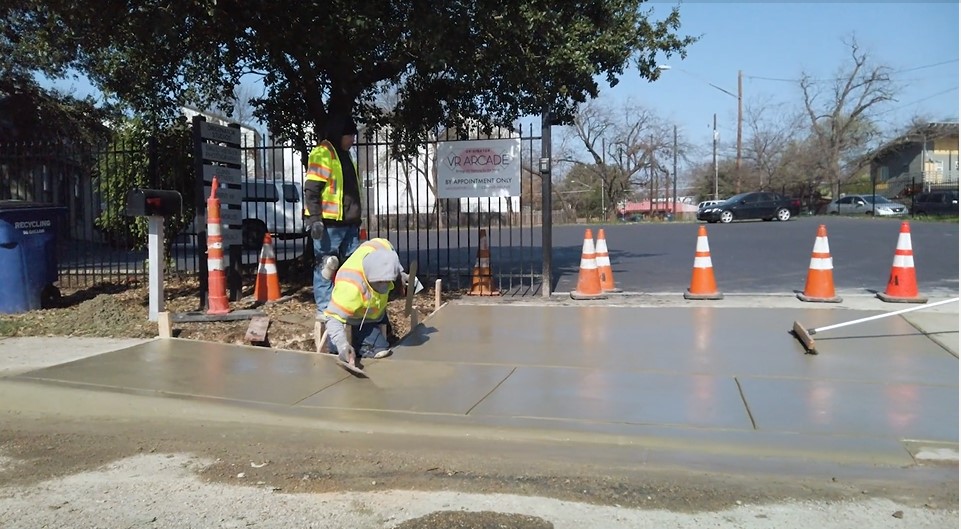
Halfway through a 10-year plan to upgrade the city’s network of sidewalks, officials say the initiative has gone better than expected but still needs considerable work to extend walkability to the majority of residents.
“It feels like a tale of two cities: It’s the best of times, it’s the worst of times,” said John Eastman, manager of the city’s Sidewalk and Special Projects Division. “Sidewalks as a transportation facility have suffered from literally decades of no funding and neglect. The fact that we’re doing great doesn’t mean that sidewalks overall are doing great.”
When City Council approved the Sidewalk Master Plan/ADA Transition Plan Update in 2016, Austin had 2,400 miles of existing sidewalks. However, only 20 percent of those sidewalks were in good condition, and approximately 40 percent of pedestrian pathways were obstructed by overgrown vegetation, according to the plan.
Five years later, Eastman and his department have doubled the reach of sidewalks in areas where people need to access them as part of their basic transportation needs, according to preliminary city estimates. Official numbers of all the city’s sidewalk infrastructure improvements are expected in the spring, Eastman said.
The Sidewalk Master Plan was adopted in 2016 with the overall goal to build out the sidewalk network. It earmarks $25 million a year for new sidewalks and $15 million a year toward repairing existing sidewalks over a 10-year period.
“Sidewalks are incredibly important,” said Heyden Black Walker, who is chair of the board for Reconnect Austin, a local transportation advocacy group. “People have been walking for as long as people have existed, for thousands of years, and we’ve just neglected that piece of our infrastructure for far too long.”
The majority of funding for the new and upgraded sidewalks comes from a combination of city bond proposals, including the 2016 mobility bond, the 2018 transportation infrastructure bond and the 2020 mobility elections bond.
In addition, the city has initiated a number of additional programs to help supplement the $25 million annual price tag, including the Corridor Mobility, the Regional Mobility and the Safe Routes to School programs.
Eastman notes that private development and redevelopment adds or repairs almost as many miles of sidewalks, if not more, than the city does each year.
“The city of Austin is sort of cranking out sidewalks, and doing it really cheaply and efficiently,” said Jay Blazek Crossley, executive director of Farm&City, a nonprofit that works on Texas public policy issues. “Every dollar going to the city sidewalk program is basically spent more efficiently than almost any other kind of public dollar.”
However, the measure of success for the city isn’t just about how much and how fast sidewalks are built – it’s also about where.
Community leaders prioritized different locations for sidewalk improvements as part of the original 2009 Sidewalk Plan process. Their recommendations factored in population density, income, health outcomes and proximity to affordable housing and transit stops.
Those deliberations “resulted in a really profoundly equitable prioritization model, “ Eastman said. “We’ve been following (it) ever since.”
Subsequent amendments in the way the city prioritizes its sidewalk projects focused on high-priority areas, where people rely more heavily on walkability and public transportation. The city has invested up to 10 times as much in some Council districts, especially along the eastern crescent of Austin, where the need is highest.
“If you can’t afford a car or you’re in a household where you only have one car but you have … two working adults, somebody’s taking transit to get to work,” Eastman said, “and you need a sidewalk and a safe route to get there.”
Despite the city’s success, Eastman says there is still much more to be done to complete the pedestrian network in Austin. And those efforts go beyond just building sidewalks.
A major focus has become safe street crossings, especially along busy corridors. The city has a growing number of busy corridors that might not have traffic lights for a half-mile or more.
“That really makes walking not a viable option,” Eastman said. “But if there’s a safe place to cross that busy street, people would walk to and from that place, and that would reduce congestion and reduce pollution.”
The new plan update expected in the spring will outline the citywide pedestrian crossing improvement plan. That is part of a broader review of the overlaps and collective goals for various mobility programs.
“The city, and especially the citizens in terms of what they’ve been willing to approve in bond funding through citizen initiatives, are definitely doing very well in terms of meeting the sidewalk plan goals,” Eastman said. “But we’ve still got a long ways to go.”
View the interactive map of Austin’s sidewalk projects currently underway.
This story was written by a journalism student at the University of Texas at Austin. The Austin Monitor is working in partnership with the UT School of Journalism to publish stories produced by students in the City and County Government Reporting course.
The Austin Monitor’s work is made possible by donations from the community. Though our reporting covers donors from time to time, we are careful to keep business and editorial efforts separate while maintaining transparency. A complete list of donors is available here, and our code of ethics is explained here.
Posted In: Planning
Do you like this story?
There are so many important stories we don't get to write. As a nonprofit journalism source, every contributed dollar helps us provide you more coverage. Do your part by donating to the nonprofit that funds the Monitor.
"make" - Google News
November 24, 2021 at 01:03PM
https://ift.tt/3nNEK2u
Austin continues to make progress on bold 2016 sidewalk initiative - Austin Monitor
"make" - Google News
https://ift.tt/2WG7dIG
https://ift.tt/2z10xgv
Bagikan Berita Ini














0 Response to "Austin continues to make progress on bold 2016 sidewalk initiative - Austin Monitor"
Post a Comment